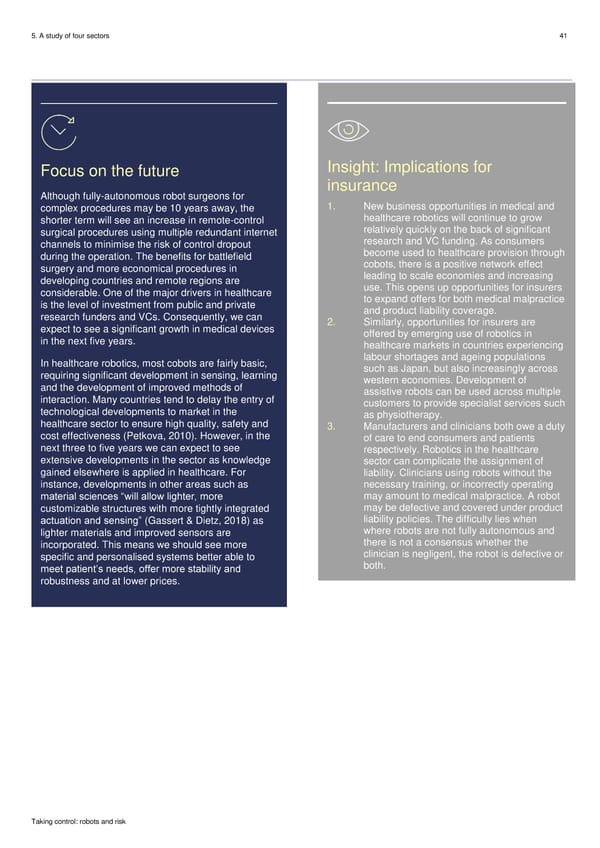5. A study of four sectors 41 Focus on the future Insight: Implications for Although fully-autonomous robot surgeons for insurance complex procedures may be 10 years away, the 1. New business opportunities in medical and shorter term will see an increase in remote-control healthcare robotics will continue to grow surgical procedures using multiple redundant internet relatively quickly on the back of significant channels to minimise the risk of control dropout research and VC funding. As consumers during the operation. The benefits for battlefield become used to healthcare provision through surgery and more economical procedures in cobots, there is a positive network effect developing countries and remote regions are leading to scale economies and increasing considerable. One of the major drivers in healthcare use. This opens up opportunities for insurers is the level of investment from public and private to expand offers for both medical malpractice research funders and VCs. Consequently, we can and product liability coverage. expect to see a significant growth in medical devices 2. Similarly, opportunities for insurers are in the next five years. offered by emerging use of robotics in healthcare markets in countries experiencing In healthcare robotics, most cobots are fairly basic, labour shortages and ageing populations requiring significant development in sensing, learning such as Japan, but also increasingly across and the development of improved methods of western economies. Development of interaction. Many countries tend to delay the entry of assistive robots can be used across multiple technological developments to market in the customers to provide specialist services such healthcare sector to ensure high quality, safety and as physiotherapy. cost effectiveness (Petkova, 2010). However, in the 3. Manufacturers and clinicians both owe a duty next three to five years we can expect to see of care to end consumers and patients respectively. Robotics in the healthcare extensive developments in the sector as knowledge sector can complicate the assignment of gained elsewhere is applied in healthcare. For liability. Clinicians using robots without the instance, developments in other areas such as necessary training, or incorrectly operating material sciences “will allow lighter, more may amount to medical malpractice. A robot customizable structures with more tightly integrated may be defective and covered under product actuation and sensing” (Gassert & Dietz, 2018) as liability policies. The difficulty lies when lighter materials and improved sensors are where robots are not fully autonomous and incorporated. This means we should see more there is not a consensus whether the specific and personalised systems better able to clinician is negligent, the robot is defective or both. meet patient’s needs, offer more stability and robustness and at lower prices. Taking control: robots and risk
 Robots & Risk Page 40 Page 42
Robots & Risk Page 40 Page 42